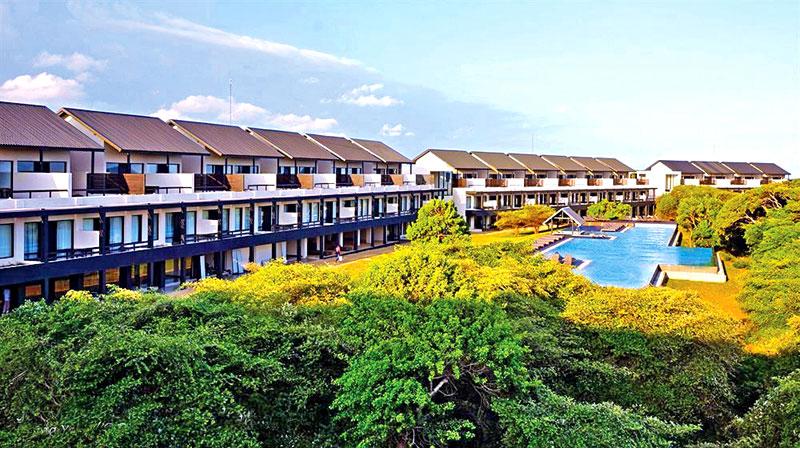
Sri Lankan history is embellished with our love for wildlife. Our glorious ancient monarchs had skilled men who were able to set up and demarcate ancient forest reserves. Within these reserves pious hermits once meditated, undisturbed by the animals. I begin my journey from Wellawaya, with much anticipation to encounter the majestic elephants, elusive leopards and other animals that live within the Yala National Park, first designated as a sanctuary in 1900. In 1806 Chief Justice Sir Alexander Johnston made note of the park, when he travelled from Trincomalee to Hambantota. The ancient Greeks it is said, were rather confused when they had first seen a leopard, so they assumed the animal was a cross between the lion (Leo) and panther (Pardus), from which we derive leopard.
Refreshing sea breeze
Today, Yala is home to 215 species of birds. One can also see wild buffalo and sloth bears at the park. Travelling down the Thanmalvilla road I see large signs that warn of elephants crossing the road. We shortly pass the Lunugamwhera National Park, which is also home to the Weharagala Reservoir. A few miles thereafter we pass through Thissamaharama.
A sign board proclaims the Sithulpawwa Rajamaha Viharaya. The ancient temple derives its name from Chiththala Pabbatha meaning - Hill of the quiet mind. It was built in the 2nd Century BC, by King Kavantissa. I did not enter the temple as we had to reach Yala.
A few buffaloes eye us lazily from the shade of a tree. A tortoise seems to have stooped in her tracks by the wayside. The refreshing sea breeze drifts into the car. I spot the first of many electric fences put up to stop elephants entering certain areas. In the early 1900s there were almost 12,000 elephants in Sri Lanka. The human- elephant conflict is a very old problem, from the time of our Kings. Both, man and beast have to co exist. I believe it is man who must make a wise compromise, for he is the one entering the jungle! In the opposite side of the road I witness many safari jeeps loaded with delighted tourists returning after their early morning safari. Some opine that there are too many jeeps entering the park, which in turn tends to disturb the animals.
Sustainability
We shortly enter the beautiful resort of Jetwing Yala, a hotel built on the serene coastline. The rooms offer a splendid view of the ocean. In addition there are ten tented villas for those who want to experience elegance and adventure mixed into one room. I meet up with Chamara, the naturalist and Thilina from Engineering who brief me on the amazing practices of sustainability, which blend in to preserve the environment. Jetwing Yala has two unique features in their daily operations.
They use renewable energy, with 100% LED lighting. The bio mass boiler is fed with cinnamon wood (which has no use after the bark is peeled for import). The cinnamon oil fuels the boiler. The second feature is the conversion of sea water into pure drinking water. It was lovely to see the bottling plant in operation and taste the water. An organic garden adds to the freshness of many vegetables. The hotel thrives on the JEEP program (Jetwing Eternal Earth Program) that enhances sustainability with nature and the community.
Chamara and I take a walk down the beach, where we spot turtle nests. The mother turtle carefully covers her nest with sea sand. Some of the local fishermen have got into the greedy habit of scouting for such nests to steal the eggs. He shows me a path frequented by “Thilak” a majestic tusker. Smaller elephants also walk through the dense bushes, especially, at night. Soon we came across a herd of wild boar, freely roaming in the hotel’s sprawling garden. I approached the herd with caution. To my surprise they remained calm. The herd had about a dozen junior pigs. I was able to get within two feet, the closest I have ever gotten to a herd of wild animals!
That night while indulging in the succulent buffet, I eagerly waited to see if the tusker would pass by. Perhaps he had opted for an alternate route! The dry season for the forests is in August and September, when the coastal trees hibernate by dropping their leaves, to conserve the water inside. This is prior to the refreshing monsoon rains. For those desiring more adventure can venture into the sea on a diving expedition that also takes you to some underwater caves and a shipwreck. Dolphins and pygmy whales can also be spotted.
Original rock salt
The next day I am ready to return to Colombo, and we decide to drive down towards Hambantota hoping to enter the Expressway. Hambantota is a paradise for peacocks. I purchase some packets of original rock salt here.
Enroute we pass the history laden town of Matara and Dondra Head (Devi Nuwara), which was once a famous emporium and pilgrimage destination with contacts from Asia, Africa, Malabar and Europe. The journey to Yala is a long drive, but surely rewarding.
One must learn to appreciate the fauna and flora bestowed on this island. We must strive to sustain our environment and keep our natural parks safe for future generations.
